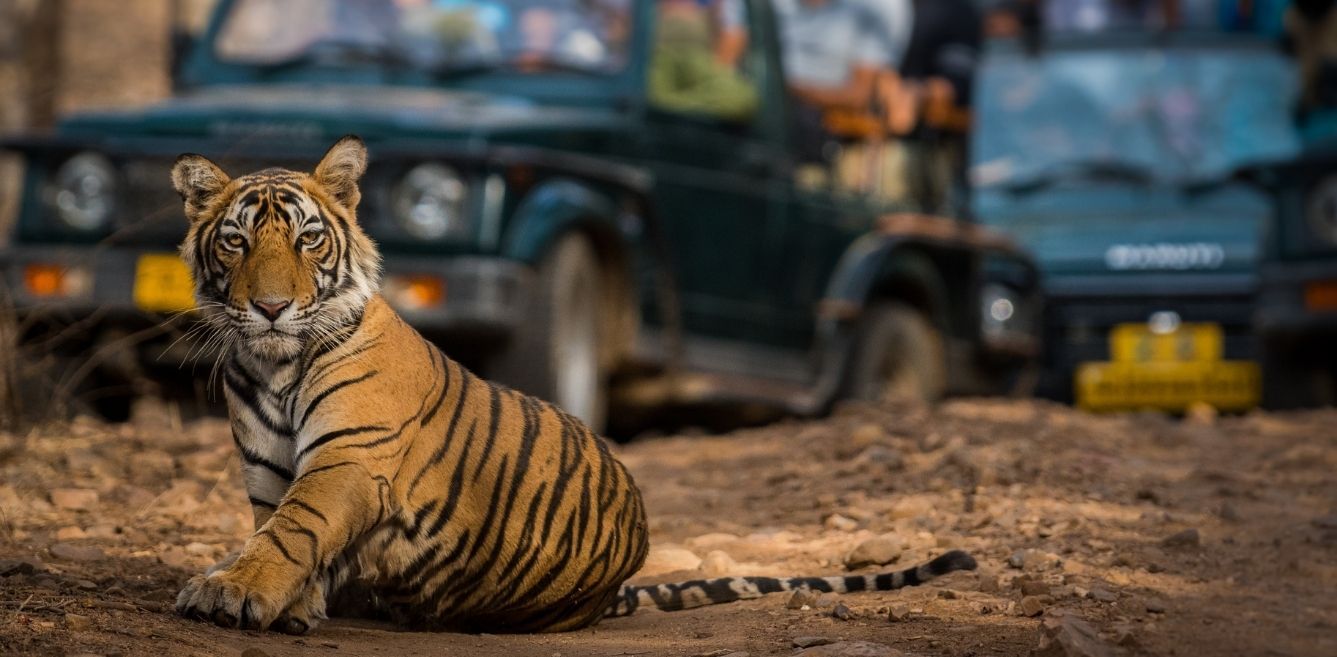Where Have They Gone? 25 Tigers Missing In Ranthambore Sparks Urgent Conservation Questions!
25 tigers vanish from Ranthambore, raising alarm! Missing apex predators disrupt ecology, spark conservation questions. Swift action needed to save them.

An alarming shake-up: Shocking information has emerged from Principal Chief Conservator of Forests (PCCF) Pavan Upadhyay, who reported that 25 out of the 75 tigers in Ranthambore National Park—located about 130 kilometres from Jaipur—have been missing over the past year. This marks the first time a significant number of tigers has been officially reported missing in a year. From 2019 to 2022, only 13 tigers disappeared from the park in the previous three years.

The disappearance of one-third of the tigers raises severe concerns about the park’s safety and sustainability. The entire conservation and wildlife enthusiast community is alarmed, as the loss of such a large number of apex predators poses a significant threat to the park’s ecological balance and raises doubts about the effectiveness of current conservation efforts.
Could poaching, territorial disputes, or gaps in technology tracking be factors? This mystery is crucial because the solution is clear: Tigers are on the brink of extinction; we need swift answers and immediate action to save this magnificent species.
One-Third of Ranthambore’s Tigers Missing: Alarming Gaps in Conservation and Management Exposed
India’s conservation efforts have been cast in a long shadow by the disappearance of one-third of Ranthambore’s tiger population. However, 25 out of the park’s 75 tigers are unaccounted for, and serious questions are being asked about the effectiveness of wildlife management and protection in one of the country’s flagship tiger reserves.
Ranthambore is famous for its work towards the Project Tiger initiative, which the country has run to protect and increase the number of its tigers. But the recent crash in tiger numbers could signal management failures, anti-poaching efforts or monitoring technology, all of which could be sapping these efforts.
Apex predators like tigers are critical to the ecosystem’s health. When this amount comes in one go, it disrupts the natural order, beginning with an increased herbivore population and impacts on vegetation and biodiversity. This incident also highlights how these camera trap-tracking techniques are fragile and reliant on an unreliable workforce and underfunded resources.

Now, conservationists are concerned that the park management may be unable to prevent poaching, track tiger movements properly, or mediate inter-specific conflicts that can trigger the displacement of one species by another.
With its tigers attracting tourists and researchers from around the world to Ranthambore, the loss will also hurt eco-tourism in this region. The fact that we can only support a one-third depletion in tiger numbers before carving up the planet as a theme park should be a stark warning that conservation is not only an enduring process but an evolutional one that constantly needs innovation and accountability.
Uncovering the Mystery: What’s Driving Tiger Disappearances in Ranthambore?
With its tigers attracting tourists and researchers from around the world to Ranthambore, the loss will also hurt eco-tourism in this region. The fact that we can only support a one-third depletion in tiger numbers before carving up the planet as a theme park should be a stark warning that conservation is an enduring and evolutionary process that constantly needs innovation and accountability.
Habitat loss and fragmentation are also strong drivers for declining tiger populations. Through human encroachment, tigers are confined to protected areas, their territories shrink, and prey becomes scarce. This can push tigers out of these zones, increasing the danger of human-wildlife conflicts.
This movement raises the risks of accidental deaths or poaching when tigers enter less secure areas. A possible solution is prioritising habitat connectivity by establishing wider wildlife corridors between fragmented habitats and minimising human presence within protected parks.

Another reasonable justification for the territorial dispute is that such a high density of tigers in the park could make tigers, even males, fight for space. Such disputes could result in injuries, or the tigers might shift to new unprotected area territory, even though they are not inside the protected area again. This risk can be minimised more efficiently by monitoring the movements, especially of young and most vulnerable tigers.
Natural factors such as ageing, diseases, and environmental threats can cause tiger deaths but rarely lead to significant population declines. These factors highlight the need for regular health assessments and veterinary care in conservation areas.

In addition, migration patterns may be influenced by tiger searches for mates, prey or space, and some tigers may go into nearby forests. The tigers’ seemingly deliberate crossing of borders raises the question of whether protection policies will also require transboundary conservation strategies with neighbouring reserves and forests to guarantee continued protection.
The causes behind the sinking tiger population can be due to many human and natural influences that negatively impact conservation. This further raises a demand for implementing a clear-cut plan to save tigers from the approaching doom, which also blocks future crises.
Ripple Effect: Impact of Tiger Decline on Ranthambore’s Ecological Balance
The declining tiger population in Ranthambore highlights their vital role as apex predators in ecosystems. Tigers help control herbivore populations like deer and wild boar, which prevents overgrazing that can harm forest vegetation and biodiversity.
However, when their population declines drastically, the number of herbivores often skyrockets, overgrazing the young trees, shrubs, and other vegetation. The grazing pressures result in alteration in the forest composition, degradation of soil quality, and interference with the regenerative stages of some plant species essential for a balanced ecosystem.

The decline is a series that disrupts the balance between predators and prey, which can lead to a trophic cascade. When herbivore populations increase and vegetation is reduced, there’s not enough food and habitat for smaller animals; birds and insects must change what they’re feeding on. This decreases biodiversity and the jungle’s potential to stay resilient to climate change.
Low tiger populations significantly impair water quality and soil conservation in the forested ecosystem. Plants help maintain the soil’s stability and water flow, thus preventing erosion and evaporation. Without adequate plant cover, water bodies within and surrounding the forest will necessitate more significant sedimentation to degrade water quality, affecting local communities and wildlife.

That loss is only one of many impacts; the diminishing tiger population has an apparent ripple effect that reaches far beyond the loss of individual tigers and, therefore, begs for urgent conservation measures to preserve the tigers and, by extension, their entire ecosystem.
Rising Poaching Threat: Organised Trade Networks Endanger India’s Tigers
Poaching is a significant threat to India’s wildlife, especially endangered tigers. The decline of tigers in Ranthambore suggests organised poaching networks capitalising on the illegal demand for tiger parts. Despite strict laws, the Wildlife Protection Society of India reported over a hundred tigers were poached between 2010 and 2020. Tigers are mainly hunted for their skin, bones, and other body parts, which are sold in illegal markets for traditional medicine and luxury goods.

In recent months, poaching attacks on reserves have again raised a red flag for the nation concerning tigers in the country. Two dead tigers were recently found at Maharashtra’s Tadoba-Andhari Tiger Reserve, all signs of which point to a clear case of poaching: removal of claws and whiskers for the illegal trade. For example, a poaching ring with multiple tiger killings was busted in 2023 in Kanha National Park, Madhya Pradesh. These illustrate that the demand for tiger parts is ongoing and how well organised and technologically adept most organised poaching groups are often to avoid patrols and trappings.
This rise in organised poaching threatens to undo decades of work in conservation. When India expands protected areas and steps up anti-poaching laws, poaching syndicates get more organised and exploit the holes in surveillance and weaknesses in forest departments that are poorly manned. Conservationists say that the only way in which organised poaching can be fought is through robust monitoring with the latest technology – real-time tracking and DNA profiling of the tiger population.
Tracking Gaps: Resource Limitations Hinder Accurate Tiger Monitoring in Ranthambore
Ranthambore tigers’ disappearance hints at suboptimal tracking methods used by wildlife authorities to determine tiger population and the resultant uncounted and wrongly counted loss. While camera trapping offers value in monitoring wildlife, it has some limits, especially in one critical primary method. If improperly placed, or even if technical issues, weather conditions or animal interference cause the camera traps to fail, tiger movements can be missed by the camera traps.

Park authorities, however, may struggle to maintain an extensive network of cameras throughout the reserve if the laws change and there are more resources and personnel needed to do so. In addition, manually identifying each tiger from these images takes time and opens up the method to human error, complicating accurate tracking.
These limitations interfere with efforts to shield tigers from future dangers, such as poaching, and they also prevent conservationists from knowing more about tiger population dynamics, health, and territory use—the latter two being in the pursuit of effective management and protection strategies.
Swift Action: Authorities Boost Surveillance and Anti-Poaching Efforts in Ranthambore
Faced with the alarming decline of tigers, park authorities and local governments have swiftly known steps to take to protect wildlife in Ranthambore. Additional camera traps have been deployed to monitor tiger movements and deter movements elsewhere, and increased surveillance efforts include additional patrols. Additional resources, including training, are going to anti-poaching teams, and authorities are considering using drones and GPS collars to monitor the location of high-risk tigers in real-time.

To manage tiger movements and prevent illegal trafficking, the government is also renewing and updating policies to support cross-border collaboration with nearby sanctuaries. These proactive steps form part of a richer suite of broader tiger habitat securing and conservation efforts that aim to keep conservation efforts robust and effective.
Outcry Over Missing Tigers: Public and Conservationists Demand Stronger Protection Measures
Tiger disappearances in Ranthambore are crying out to public conservation groups and environmentalists to protect India’s tiger populations. While the conservation organisations that heavily depend on this ecosystem raise their voices in deep concern, they point out that a loss of so many animals affects, not to mention undercuts, a lot of work they have already put into conservation over the years, and jeopardises the balance of the park’s ecosystem.
This is a wake-up call for environmentalists and park management to be held to higher accountability and transparency standards to increase transparency and accountability for wildlife protection.

Citizens reacted to the news civilly on social media, a rare occurrence. They indicated sorrow but primarily frustration with how little has been done to protect India’s national animals from poaching and habitat loss. Combined, these voices express a unified call for immediate tiger conservation, likening it to a severe disease that must be addressed quickly to prevent damage to ecological health and biodiversity.
This disappearance of tigers in Ranthambore darkens India’s otherwise good global reputation as the leading country for tiger conservation, particularly given the role played by India in Project Tiger. Cutting today’s India down to size is difficult at a time when the program has been hailed as a model for tiger protection by achieving significant success in increasing its tiger population over the years.
Calls for Transparency Mount as Tiger Losses Threaten India’s Conservation and Eco-Tourism
The recent disappearances of tigers at Ranthambore National Park have again forced the government to pressure itself to increase transparency in wildlife protection. It is as much a representation of India as it is an attractive spot for eco-tourism. In response to these incidents, there has been an increased call from the government to ensure proper measures in wildlife protection, considering the tiger as the symbol of India and a primary attraction for eco-tourism.

Since tiger tourism is heavily based on eco-tourism, maintaining public trust is essential for preserving the tigers’ health and sustainable livelihoods based on wildlife tourism. The emphasis on transparency comes not only as a reaction to a scandal of horrific proportions regarding the government’s commitment to India’s sacred, threatened animal but also as a louder call for the government to take action for this iconic species that is visible and holds it accountable.
Strengthening Tiger Conservation: The Urgent Need for Advanced Tracking, Funding, and Anti-Poaching Laws
The disappearance of tigers in Ranthambore calls for sterner tracking technologies, better-funded conservation programs and anti-poaching legislation: India needs more tiger protection. The type of tracking solutions that go with the rise in high-tech and luxurious technology would help the authorities track tigers’ movements and, hence, avert all possible threats, whether from the poachers or the industries entering their habitat.

Augmentation of funding is equally important for conservation because limited funds usually leave the park staff without regular patrolling, camera trap maintenance, and proper deployment of protective measures. If anti-poaching laws are enforced strictly, several punitive measures will become deterrent enough to strengthen penalties and sanctions against offenders. All these measures can protect the tiger and the larger ecosystem and make India a forerunner in wildlife conservation.




